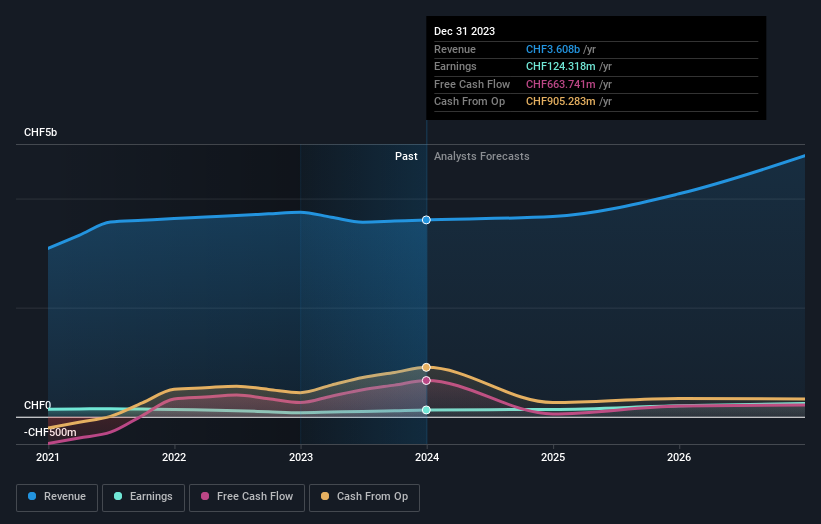While private equity firms own 31% of Stadler Rail AG (VTX:SRAIL), retail investors are its largest shareholders with 39% ownership
Key Insights
Significant control over Stadler Rail by retail investors implies that the general public has more power to influence management and governance-related decisions
A total of 7 investors have a majority stake in the company with 51% ownership
To get a sense of who is truly in control of Stadler Rail AG (VTX:SRAIL), it is important to understand the ownership structure of the business. With 39% stake, retail investors possess the maximum shares in the company. Put another way, the group faces the maximum upside potential (or downside risk).
And private equity firms on the other hand have a 31% ownership in the company.
Let's take a closer look to see what the different types of shareholders can tell us about Stadler Rail.
View our latest analysis for Stadler Rail
What Does The Institutional Ownership Tell Us About Stadler Rail?
Many institutions measure their performance against an index that approximates the local market. So they usually pay more attention to companies that are included in major indices.
Stadler Rail already has institutions on the share registry. Indeed, they own a respectable stake in the company. This implies the analysts working for those institutions have looked at the stock and they like it. But just like anyone else, they could be wrong. If multiple institutions change their view on a stock at the same time, you could see the share price drop fast. It's therefore worth looking at Stadler Rail's earnings history below. Of course, the future is what really matters.
Hedge funds don't have many shares in Stadler Rail. The company's largest shareholder is PCS Holding AG, with ownership of 31%. For context, the second largest shareholder holds about 11% of the shares outstanding, followed by an ownership of 3.2% by the third-largest shareholder. Peter Spuhler, who is the second-largest shareholder, also happens to hold the title of Top Key Executive.
We also observed that the top 7 shareholders account for more than half of the share register, with a few smaller shareholders to balance the interests of the larger ones to a certain extent.
While studying institutional ownership for a company can add value to your research, it is also a good practice to research analyst recommendations to get a deeper understand of a stock's expected performance. Quite a few analysts cover the stock, so you could look into forecast growth quite easily.
Insider Ownership Of Stadler Rail
While the precise definition of an insider can be subjective, almost everyone considers board members to be insiders. Management ultimately answers to the board. However, it is not uncommon for managers to be executive board members, especially if they are a founder or the CEO.
Most consider insider ownership a positive because it can indicate the board is well aligned with other shareholders. However, on some occasions too much power is concentrated within this group.
Our most recent data indicates that insiders own a reasonable proportion of Stadler Rail AG. It is very interesting to see that insiders have a meaningful CHF378m stake in this CHF2.6b business. Most would say this shows a good degree of alignment with shareholders, especially in a company of this size. You can click here to see if those insiders have been buying or selling.
General Public Ownership
With a 39% ownership, the general public, mostly comprising of individual investors, have some degree of sway over Stadler Rail. While this size of ownership may not be enough to sway a policy decision in their favour, they can still make a collective impact on company policies.
Private Equity Ownership
Private equity firms hold a 31% stake in Stadler Rail. This suggests they can be influential in key policy decisions. Some investors might be encouraged by this, since private equity are sometimes able to encourage strategies that help the market see the value in the company. Alternatively, those holders might be exiting the investment after taking it public.
Next Steps:
It's always worth thinking about the different groups who own shares in a company. But to understand Stadler Rail better, we need to consider many other factors. For instance, we've identified 1 warning sign for Stadler Rail that you should be aware of.
If you are like me, you may want to think about whether this company will grow or shrink. Luckily, you can check this free report showing analyst forecasts for its future.
NB: Figures in this article are calculated using data from the last twelve months, which refer to the 12-month period ending on the last date of the month the financial statement is dated. This may not be consistent with full year annual report figures.
Have feedback on this article? Concerned about the content? Get in touch with us directly. Alternatively, email editorial-team (at) simplywallst.com.
This article by Simply Wall St is general in nature. We provide commentary based on historical data and analyst forecasts only using an unbiased methodology and our articles are not intended to be financial advice. It does not constitute a recommendation to buy or sell any stock, and does not take account of your objectives, or your financial situation. We aim to bring you long-term focused analysis driven by fundamental data. Note that our analysis may not factor in the latest price-sensitive company announcements or qualitative material. Simply Wall St has no position in any stocks mentioned.
Have feedback on this article? Concerned about the content? Get in touch with us directly. Alternatively, email editorial-team@simplywallst.com

 Yahoo Finance
Yahoo Finance 

